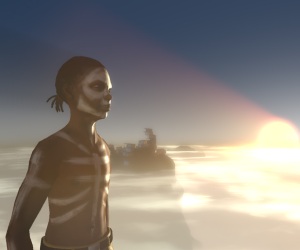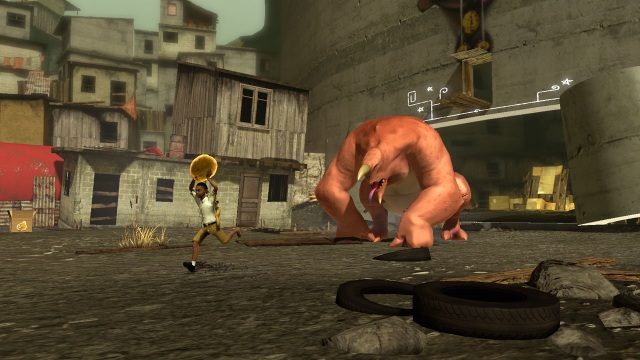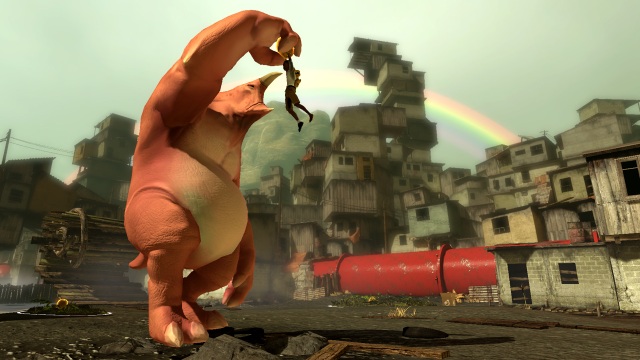Papo & Yo Review
 Game: Papo & Yo
Game: Papo & Yo
Developer: Minority
Publisher: Sony Computer Entertainment
Available on: PlayStation 3 Only
No matter what horrors are thrown at them, children are remarkably resilient, and often understand a lot more about life that we give them credit for. They are also masters of escapism, often making the best out of dire situations, adapting far better than grown ups.
This is a concept that has been explored considerably in books and films. There is the relatively tame story of Max escaping from a telling off to become the King of All Wild Things; Satsuki and Mei frolicking with Totoro under the camphor tree as their mother lies sick in the hospital, and of course the unforgettable tale of Ofelia escaping the horrors of the Spanish Civil War, a wicked stepfather and the ordeals of her poor mother in Pan’s Labyrinth. All of these examples show not only the rampant imaginations of our younger selves, but also the way a child is able to accept so readily and interact with potentially intimidating monsters.
Popo & Yo designer Vander Caballero had his own demons as a child, and has very bravely decided to wear the scars of his childhood for all to see on his debut. It isn’t every day that a video game opens up with a dedication as poignant and raw as “To my mother, brother and sisters with whom I survived the monster of my father”. It is a stark, ominous opening gambit which gives way to a vignette of the game’s child protagonist Quico cowering inside a closet as a monstrous presence rampages outside. The spectre of Caballero’s alcoholic father looms large over this unusual, emotionally charged but incredibly brave game.

Once he has escaped from his temporary prison, Quico finds himself in a rundown favela, a sprawling maze of crumbling tin-roofed shacks stretching as far as the eye can see, where he sets off in pursuit of a mysterious child, following a set of white rune-like insignia on the walls and floors that signify the in-game puzzles that need to be solved in order to progress. Scenery can be pulled around to create steps and bridges, levers and cogs have to be activated to open up the next area, keys need to be used to shift things around in this strange fantasy world. Before long, you are introduced to Lula, a toy robot that the boy carries around with him, who comes to life and grants the ability to hover in midair, or act as a long range projectile who can be thrown to activate the glowing puzzle glyphs. It is by using Lula that you find the huge, lumbering Monster, who goes on to play a fundamental role in the rest of the adventure.
So obviously a metaphor for the father that Caballero lived in fear of during his formative years, Monster is initially docile and can be manipulated to solve puzzles by luring him around the scenery with coconuts that he enjoys devouring and will gravitate towards. Feed him enough fruit and he will fall asleep, where he doubles up as a trampoline used to reach far flung platforms. The mood of the game changes dramatically with the introduction of tree frogs, a delicacy that the beast is infinitely more interested in, causing a near-frenzied state if he can sense one nearby.

Allowing Monster to ingest one of the brightly coloured amphibians sends him into a maniacal, hellacious state, glowing an ominous red and spouting flames, a transformed state that causes him to pursue Quico and grip him in a violent embrace. An allegory, perhaps, for the violence the author experienced at the hands of his alcoholic father, the first time you witness Monster in this horrifying guise is unexpected and genuinely disturbing.
Quico’s tale is drip-fed in a series of unsettling flashbacks and cutscenes, and forms a strong backdrop to a game that has a peerless, undeniable emotional power. Sadly, what could have been another offbeat stunner along the lines of its magnificent spiritual cousin Journey, suffers from having gameplay that is formulaic and boring, with far too much repetition and puzzles that feel more like a chore and a means to an end than achievements that give a sense of accomplishment. Technically the game is also quite rough around the edges, with some suspect framerate issues, a great deal of screen tearing and some cumbersome camera angles.

VERDICT: Putting things into perspective, it is very easy for me to forgive the issues that plague Papo & Yo; it is a truly special, highly original game, which managed to enchant and disturb in equal measure. How can you not admire a work that contains so much of its creator’s heart and soul, his own personal experiences, his own deepest, darkest thoughts and feelings manifested in pixel form? It certainly evoked very personal feelings of my own, which I will not elaborate upon here.
It shares, with the likes of Miyazaki’s finest works, the fantastical sense of what it means to inhabit and view the world through the eyes of a child, a place where walking alongside a hideous, glowering monster seems somehow more natural and makes perfect sense. This game is how Caballero has chosen to confront his demons, and for that it is truly something to be admired.





